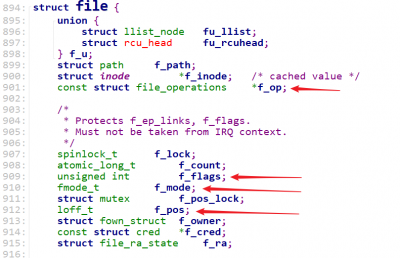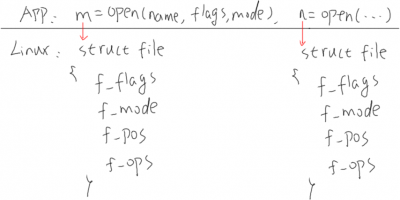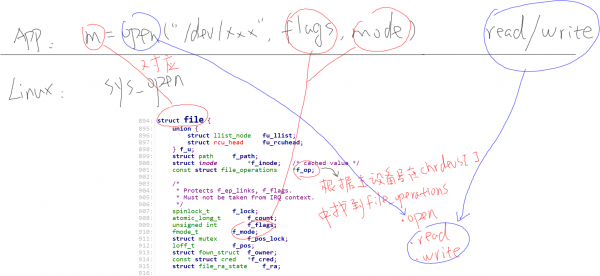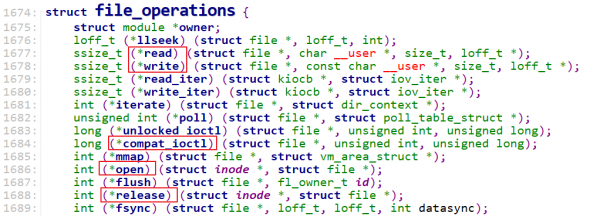ELADCMSecondEditionChapterFivePartⅡ
来自百问网嵌入式Linux wiki
__NOTITLE__
目录
Hello驱动(不涉及硬件操作)
- 我们选用的内核都是4.x版本,操作都是类似的:
rk3399 linux 4.4.154
rk3288 linux 4.4.154
imx6ul linux 4.9.88
am3358 linux 4.9.168APP打开的文件在内核中如何表示
- APP打开文件时,可以得到一个整数,这个整数被称为文件句柄。对于APP的每一个文件句柄,在内核里面都有一个“struct file”与之对应。
- 可以猜测,我们使用open打开文件时,传入的flags、mode等参数会被记录在内核中对应的struct file结构体里(f_flags、f_mode):
int open(const char *pathname, int flags, mode_t mode);打开字符设备节点时,内核中也有对应的struct file
请猜猜怎么编写驱动程序
- ① 确定主设备号,也可以让内核分配
- ② 定义自己的file_operations结构体
- ③ 实现对应的drv_open/drv_read/drv_write等函数,填入file_operations结构体
- ④ 把file_operations结构体告诉内核:register_chrdev
- ⑤ 谁来注册驱动程序啊?得有一个入口函数:安装驱动程序时,就会去调用这个入口函数
- ⑥ 有入口函数就应该有出口函数:卸载驱动程序时,出口函数调用unregister_chrdev
- ⑦ 其他完善:提供设备信息,自动创建设备节点:class_create, device_create
请不要啰嗦,表演你的代码吧
写驱动程序
- 参考driver/char中的程序,包含头文件,写框架,传输数据:
- A. 驱动中实现open, read, write, release,APP调用这些函数时,都打印内核信息
- B. APP调用write函数时,传入的数据保存在驱动中
- C. APP调用read函数时,把驱动中保存的数据返回给APP
- 使用GIT下载所有源码后,本节源码位于如下目录:
01_all_series_quickstart\04_快速入门(正式开始)\
02_嵌入式Linux驱动开发基础知识\source\01_hello_drv\hello_drv.c- hello_drv.c源码如下:
#include <linux/module.h>
#include <linux/fs.h>
#include <linux/errno.h>
#include <linux/miscdevice.h>
#include <linux/kernel.h>
#include <linux/major.h>
#include <linux/mutex.h>
#include <linux/proc_fs.h>
#include <linux/seq_file.h>
#include <linux/stat.h>
#include <linux/init.h>
#include <linux/device.h>
#include <linux/tty.h>
#include <linux/kmod.h>
#include <linux/gfp.h>
/* 1. 确定主设备号 */
static int major = 0;
static char kernel_buf[1024];
static struct class *hello_class;
#define MIN(a, b) (a < b ? a : b)
/* 3. 实现对应的open/read/write等函数,填入file_operations结构体 */
static ssize_t hello_drv_read (struct file *file, char __user *buf, size_t size, loff_t *offset)
{
int err;
printk("%s %s line %d\n", __FILE__, __FUNCTION__, __LINE__);
err = copy_to_user(buf, kernel_buf, MIN(1024, size));
return MIN(1024, size);
}
static ssize_t hello_drv_write (struct file *file, const char __user *buf, size_t size, loff_t *offset)
{
int err;
printk("%s %s line %d\n", __FILE__, __FUNCTION__, __LINE__);
err = copy_from_user(kernel_buf, buf, MIN(1024, size));
return MIN(1024, size);
}
static int hello_drv_open (struct inode *node, struct file *file)
{
printk("%s %s line %d\n", __FILE__, __FUNCTION__, __LINE__);
return 0;
}
static int hello_drv_close (struct inode *node, struct file *file)
{
printk("%s %s line %d\n", __FILE__, __FUNCTION__, __LINE__);
return 0;
}
/* 2. 定义自己的file_operations结构体 */
static struct file_operations hello_drv = {
.owner = THIS_MODULE,
.open = hello_drv_open,
.read = hello_drv_read,
.write = hello_drv_write,
.release = hello_drv_close,
};
/* 4. 把file_operations结构体告诉内核:注册驱动程序 */
/* 5. 谁来注册驱动程序啊?得有一个入口函数:安装驱动程序时,就会去调用这个入口函数 */
static int __init hello_init(void)
{
int err;
printk("%s %s line %d\n", __FILE__, __FUNCTION__, __LINE__);
major = register_chrdev(0, "hello", &hello_drv); /* /dev/hello */
hello_class = class_create(THIS_MODULE, "hello_class");
err = PTR_ERR(hello_class);
if (IS_ERR(hello_class)) {
printk("%s %s line %d\n", __FILE__, __FUNCTION__, __LINE__);
unregister_chrdev(major, "hello");
return -1;
}
device_create(hello_class, NULL, MKDEV(major, 0), NULL, "hello"); /* /dev/hello */
return 0;
}
/* 6. 有入口函数就有出口函数:卸载驱动程序时就会去调用这个出口函数 */
static void __exit hello_exit(void)
{
printk("%s %s line %d\n", __FILE__, __FUNCTION__, __LINE__);
device_destroy(hello_class, MKDEV(major, 0));
class_destroy(hello_class);
unregister_chrdev(major, "hello");
}
/* 7. 其他完善:提供设备信息,自动创建设备节点 */
module_init(hello_init);
module_exit(hello_exit);
MODULE_LICENSE("GPL");- 阅读一个驱动程序,从它的入口函数开始,第66行就是入口函数。它的主要工作就是第71行,向内核注册一个file_operations结构体:hello_drv,这就是字符设备驱动程序的核心。
- file_operations结构体hello_drv在第56行定义,里面提供了open/read/write/release成员,应用程序调用open/read/write/close时就会导致这些成员函数被调用。
- file_operations结构体hello_drv中的成员函数都比较简单,大多数只是打印而已。要注意的是,驱动程序和应用程序之间传递数据要使用copy_from_user/copy_to_user函数。
写测试程序
- 测试程序要实现写、读功能:
A. ./hello_drv_test -w wiki.100ask.net // 把字符串“wiki.100ask.net”发给驱动程序
B. ./hello_drv_test -r // 把驱动中保存的字符串读回来- 使用GIT下载所有源码后,本节源码位于如下目录:
01_all_series_quickstart\04_快速入门(正式开始)\
02_嵌入式Linux驱动开发基础知识\source\01_hello_drv\hello_drv_test.c- hello_drv_test.c源码如下:
#include <sys/types.h>
#include <sys/stat.h>
#include <fcntl.h>
#include <unistd.h>
#include <stdio.h>
#include <string.h>
/*
* ./hello_drv_test -w abc
* ./hello_drv_test -r
*/
int main(int argc, char **argv)
{
int fd;
char buf[1024];
int len;
/* 1. 判断参数 */
if (argc < 2)
{
printf("Usage: %s -w <string>\n", argv[0]);
printf(" %s -r\n", argv[0]);
return -1;
}
/* 2. 打开文件 */
fd = open("/dev/hello", O_RDWR);
if (fd == -1)
{
printf("can not open file /dev/hello\n");
return -1;
}
/* 3. 写文件或读文件 */
if ((0 == strcmp(argv[1], "-w")) && (argc == 3))
{
len = strlen(argv[2]) + 1;
len = len < 1024 ? len : 1024;
write(fd, argv[2], len);
}
else
{
len = read(fd, buf, 1024);
buf[1023] = '\0';
printf("APP read : %s\n", buf);
}
close(fd);
return 0;
}测试
- A. 编写驱动程序的Makefile
- 驱动程序中包含了很多头文件,这些头文件来自内核,不同的ARM板它的某些头文件可能不同。所以编译驱动程序时,需要指定板子所用的内核的源码路径。
- 要编译哪个文件?这也需要指定,设置obj-m变量即可
- 怎么把.c文件编译为驱动程序.ko?这要借助内核的顶层Makefile。
- 本驱动程序的Makefile内容如下:
01
02 # 1. 使用不同的开发板内核时, 一定要修改KERN_DIR
03 # 2. KERN_DIR中的内核要事先配置、编译, 为了能编译内核, 要先设置下列环境变量:
04 # 2.1 ARCH, 比如: export ARCH=arm64
05 # 2.2 CROSS_COMPILE, 比如: export CROSS_COMPILE=aarch64-linux-gnu-
06 # 2.3 PATH, 比如: export PATH=$PATH:/home/book/100ask_roc-rk3399-pc/ToolChain-6.3.1/gcc-linaro-6.3.1-2017.05-x86_64_aarch64-linux-gnu/bin
07 # 注意: 不同的开发板不同的编译器上述3个环境变量不一定相同,
08 # 请参考各开发板的高级用户使用手册
09
10 KERN_DIR = /home/book/100ask_roc-rk3399-pc/linux-4.4
11
12 all:
13 make -C $(KERN_DIR) M=`pwd` modules
14 $(CROSS_COMPILE)gcc -o hello_drv_test hello_drv_test.c
15
16 clean:
17 make -C $(KERN_DIR) M=`pwd` modules clean
18 rm -rf modules.order
19 rm -f hello_drv_test
20
21 obj-m += hello_drv.o- 先设置好交叉编译工具链,编译好你的板子所用的内核,然后修改Makefile指定内核源码路径,最后即可执行make命令编译驱动程序和测试程序。
- B. 上机实验
- 注意:我们是在Ubuntu中编译程序,但是需要在ARM板子上测试。所以需要把程序放到ARM板子上。
- 启动单板后,可以通过NFS挂载Ubuntu的某个目录,访问该目录中的程序。
- 测试示例:
- ① 在Ubuntu上编译好驱动,并它复制到NFS目录:
$ cp *.ko hello_drv_test ~/nfs_rootfs/- ② 在ARM板上测试:
# echo "7 4 1 7" > /proc/sys/kernel/printk // 打开内核的打印信息,有些板子默认打开了
# ifconfig eth0 192.168.1.100 // 配置ARM板IP,下面是挂载NFS文件系统
# mount -t nfs -o nolock,vers=3 192.168.1.137:/home/book/nfs_rootfs /mnt
# cd /mnt
# insmod hello_drv.ko // 安装驱动程序
[ 293.594910] hello_drv: loading out-of-tree module taints kernel.
[ 293.616051] /home/book/source/01_hello_drv/hello_drv.c hello_init line 70
# ls /dev/hello -l // 驱动程序会生成设备节点
crw------- 1 root root 236, 0 Jan 18 08:55 /dev/hello
# ./hello_drv_test // 查看测试程序的用法
Usage: ./hello_drv_test -w <string>
./hello_drv_test -r
# ./hello_drv_test -w wiki.100ask.net // 往驱动程序中写入字符串
[ 318.360800] /home/book/source/01_hello_drv/hello_drv.c hello_drv_open line 45
[ 318.372570] /home/book/source/01_hello_drv/hello_drv.c hello_drv_write line 38
[ 318.382854] /home/book/source/01_hello_drv/hello_drv.c hello_drv_close line 51
# ./hello_drv_test -r // 从驱动程序中读出字符串
[ 326.177890] /home/book/source/01_hello_drv/hello_drv.c hello_drv_open line 45
[ 326.198304] /home/book/source/01_hello_drv/hello_drv.c hello_drv_read line 30
APP read : wiki.100ask.net
[ 326.214782] /home/book/source/01_hello_drv/hello_drv.c hello_drv_close line 51- 注意:如果安装驱动时提示version magic不匹配,请看本文档最后的“常见问题”。




